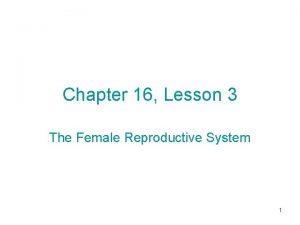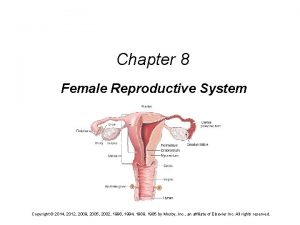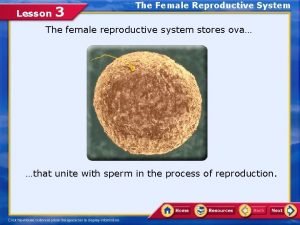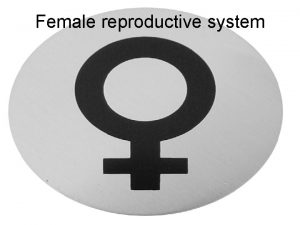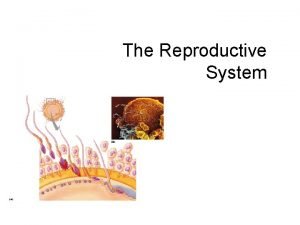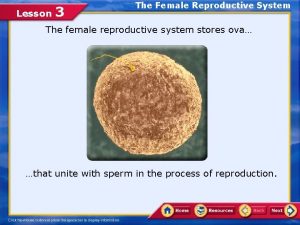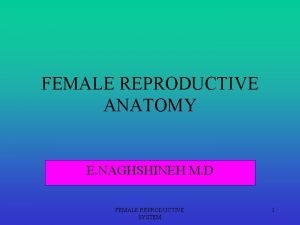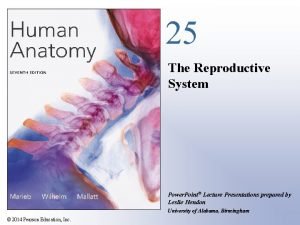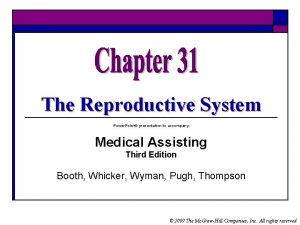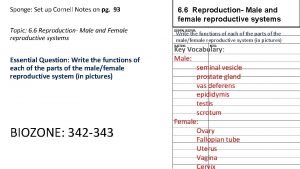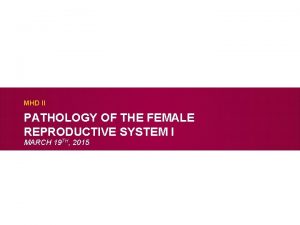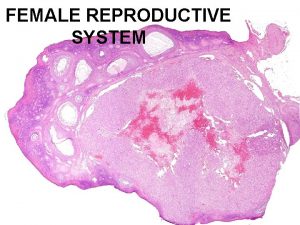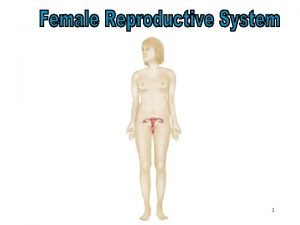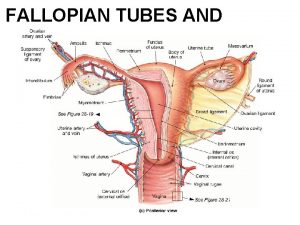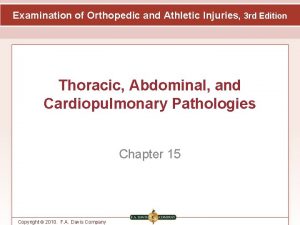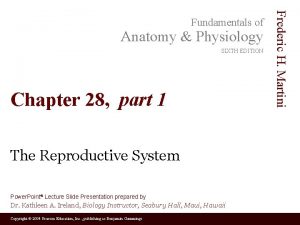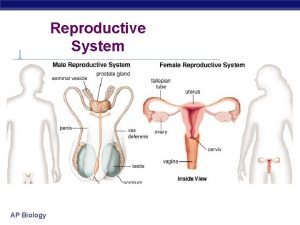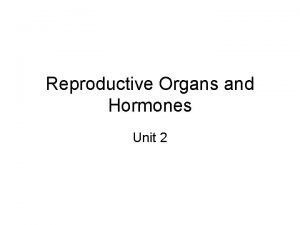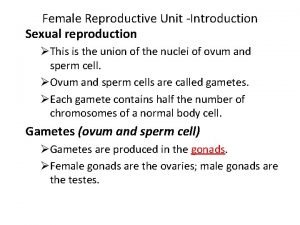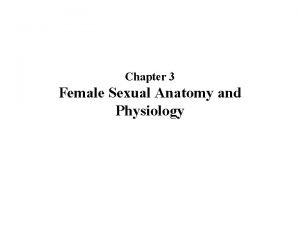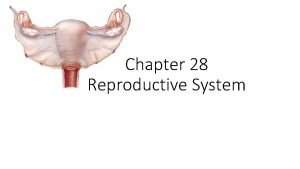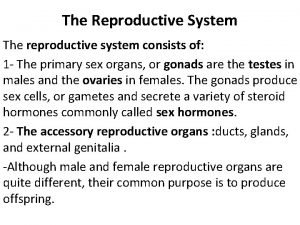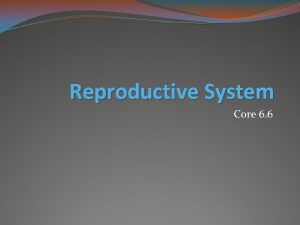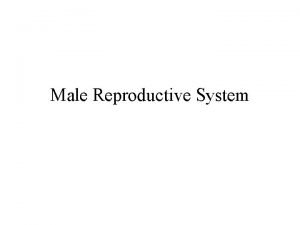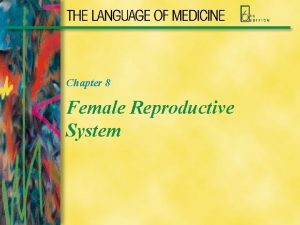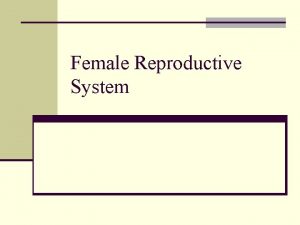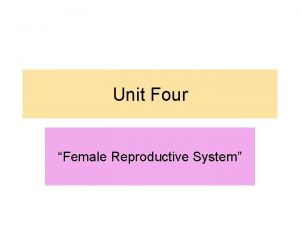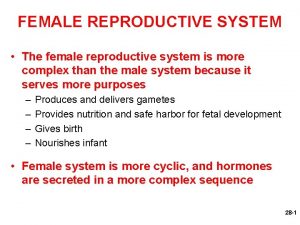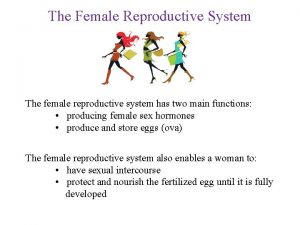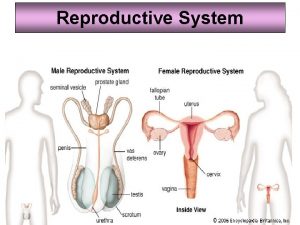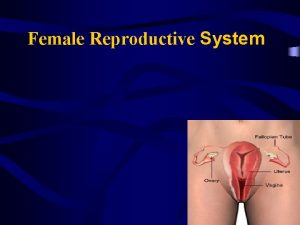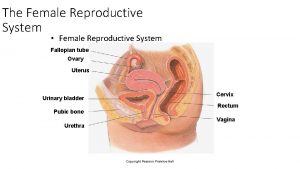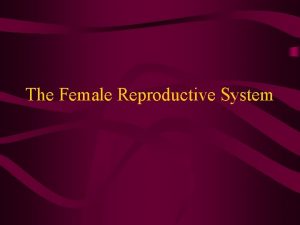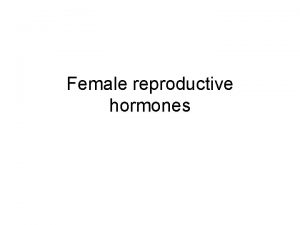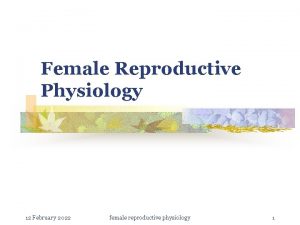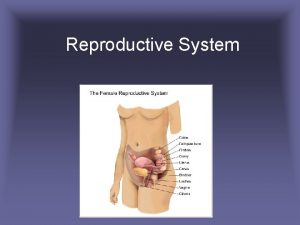CHAPTER 17 Female Reproductive System Female Reproductive System





























































- Slides: 61

CHAPTER 17 Female Reproductive System

Female Reproductive System Overview • Purpose of female reproductive system – Reproduction – Secretes hormones that support secondary sex characteristic changes – Secretes hormones that sustain pregnancy should fertilization occur 2

External Genitalia • Mons pubis – Fatty tissue that covers and cushions symphysis pubis • Labia majora – Two folds of skin containing fatty tissue and covered with hair • Located on either side of the vaginal opening, extending from the mons pubis to the perineum 3

External Genitalia • Labia minora – Two thin folds of tissue located within the folds of the labia majora • Extends from the clitoris downward toward the perineum • Bartholin’s glands – Located on either side of the vaginal orifice • Secrete a mucous substance that lubricates the vagina 4

External Genitalia • Clitoris – Short, elongated organ composed of erectile tissue – Located just behind the upper junction of the labia minora – Homologous to the penis • Urinary orifice – Not true part of female reproductive system, but part of the vulva 5

External Genitalia • Vaginal orifice – Located in lower portion of the vestibule, below the urinary meatus – Also known as the vaginal introitus • Perineum – Area between vaginal orifice and anus – Consists of muscular and fibrous tissue and serves as support for pelvic structures 6

Internal Genitalia • Vagina – Muscular tube that connects the uterus with the vulva • Rests between bladder (anteriorly) and rectum (posteriorly) – Stretchable folds of inner lining known as rugae • Capable of expanding during childbirth to permit passage of baby’s head without tearing lining 7

Internal Genitalia • Uterus – Pear-shaped, hollow, muscular organ that houses the fertilized implanted ovum as it develops throughout pregnancy • Source of monthly menstrual flow if pregnancy does not occur 8

Internal Genitalia • Uterus – Three identifiable portions • Fundus – Small dome-shaped upper portion • Body – Central portion • Cervix – Narrower, necklike portion at lower end 9

Internal Genitalia • Wall of uterus contains three layers – Perimetrium • Outermost serous membrane layer – Myometrium • Middle, muscular layer – Endometrium • Innermost layer, highly vascular 10

Internal Genitalia • Fallopian tubes – Also known as uterine tubes or oviducts – Serve as passageway for the ova as they exit the ovary enroute to the uterus – Free end of each tube ends in fingerlike projections called fimbriae • Fimbriated ends draw ovum into tube through wavelike motions when ovum is released from ovary 11

Internal Genitalia • Ovaries – Female sex cells = female gonads – Almond-shaped pair of ovaries, held in place by ligaments – Responsible for: • Producing mature ova and releasing them at monthly intervals • Producing hormones necessary for normal growth and development of female • Producing hormones necessary for maintaining pregnancy should it occur 12

Mammary Glands (Breasts) • Mammary glands – Known as the breasts – Responsible for production of milk (lactation) – Consist of glandular tissue with supporting adipose tissue and fibrous connective tissue, covered with skin 13

Mammary Glands (Breasts) • Structures of the breasts – Nipple • Located at center of each breast • Consists of sensitive erectile tissue – Areola • Darker pigmented area surrounding the nipple • Montgomery’s tubercles – Small sebaceous glands present in areola 14

Mammary Glands (Breasts) • Tissues of the breasts – Adipose – Connective – Glandular • Lactiferous ducts – Narrow tubular structures of the breast that transport milk to the nipple for breastfeeding 15

Female Pelvis • Landmarks of the pelvis – True pelvis boundaries – Sacrum, coccyx, pubic bone, ischial spines – Serve as reference points for measuring across pelvic outlet from varying angles – Measurement determines size of pelvic 16

Puberty and the Menstrual Cycle • Puberty – Period of life at which the ability to reproduce begins – Female reproductive organs are fully developed – Secondary sex characteristic changes occur 17

Puberty and the Menstrual Cycle • Menstrual cycle – Menstrual Phase • Days 1 – 5 • Menstrual flow occurs on day one and last for 3 to 5 days – Postmenstrual Phase • Days 6 – 12 • Interval between menses and ovulation 18

Puberty and the Menstrual Cycle • Menstrual cycle – Ovulatory Phase • Days 13 – 14 • Graafian follicle ruptures, releasing mature ovum into pelvic cavity = ovulation – Premenstrual Phase • Days 15 – 28 • Phase between ovulatory phase and onset of menstrual flow 19

Common Signs and Symptoms • Amenorrhea – Absence of menstrual flow • Dysmenorrhea – Painful menstrual flow • Menorrhagia – Abnormally long or very heavy menstrual periods 20

Common Signs and Symptoms • Metrorrhagia – Uterine bleeding at times other than the menstrual period • Oligomenorrhea – Abnormally light or infrequent menstruation 21

Forms of Contraception • Abstinence – Abstaining from having vaginal intercourse – Advantage: • 100 percent effective 22

Forms of Contraception • Oral contraceptives – Birth control pills – Contain synthetic forms of the hormones, estrogen and progesterone • Advantages • Disadvantage 23

Forms of Contraception • Depro-Provera injection – Form of contraception administered intramuscularly, approximately once every 12 weeks • Advantages • Disadvantages 24

Forms of Contraception • Intrauterine device – Small plastic T-shaped device inserted into the uterus to prevent implantation of an ovum into the uterus • Advantages • Disadvantages 25

Forms of Contraception • Birth control patch – Thin, flexible square skin patch that continuously delivers hormones into the bloodstream for a full seven days to prevent pregnancy • Advantages • Disadvantages 26

Forms of Contraception • Barrier methods – Methods of birth control that place physical barriers between the cervix and the sperm – Sperm cannot pass the cervix and enter the uterus, and thus the fallopian tubes – Examples: • Spermicidal jellies and creams • Condoms • Diaphragms 27

Forms of Contraception • Permanent methods of birth control – Tubal ligation – Surgically cutting and tying the fallopian tubes to prevent passage of ova or sperm through the tubes • Prevents pregnancy • Known as female sterilization 28

Forms of Contraception Tubal Ligation 29

Forms of Contraception • Permanent methods of birth control • Micro-insert system • Alternate to tubal ligation • Provides bilateral occlusion of fallopian tubes by inserting a soft, flexible micro-insert into each fallopian tube • Requires no incisions and can be performed without general anesthesia 30

Forms of Contraception • Permanent methods of birth control – Vasectomy – Male sterilization – Surgically cutting and tying the vas deferens to prevent passage of sperm • Prevents pregnancy 31

Permanent Methods of Birth Control Vasectomy 32

PATHOLOGICAL CONDITIONS Female Reproductive System

Carcinoma of the Breast • Pronounced – (car-sin-OH-mah of the breast) • Defined – Malignant tumor of the breast tissue – Most common type (ductal carcinoma) originates in the mammary ducts • Has ability to invade surrounding tissue if not detected early enough 34

Cervical Carcinoma • Pronounced – (SER-vih-kal car-sin-OH-mah) • Defined – Malignant tumor of the cervix • Symptoms include bleeding between menstrual periods, after sexual intercourse, after menopause, and an abnormal Pap smear 35

Cervicitis • Pronounced – (ser-vih-SIGH-tis) • Defined – Acute or chronic inflammation of the uterine cervix 36

Cystocele • Pronounced – (SIS-toh-seel) • Defined – Herniation or downward protrusion of the urinary bladder through the wall of the vagina 37

Endometrial Carcinoma • Pronounced – (en-doh-MEE-tree-al car-sin-OH-mah) • Defined – Malignant tumor of the inner lining of the uterus – Also known as adenocarcinoma of the uterus 38

Endometriosis • Pronounced – (en-doh-mee-tree-OH-sis) • Defined – Presence and growth of endometrial tissue in areas outside the endometrium • Lining of the uterus 39

Fibrocystic Breast Disease • Pronounced – (figh-broh-SIS-tik breast dih-ZEEZ) • Defined – Presence of single or multiple fluid-filled cysts that are palpable in the breasts • Cysts are benign and fluctuate in size with the menstrual period 40

Fibroid Tumor • Pronounced – (FIGH-broyd tumor) • Defined – A benign, fribous tumor of the uterus 41

Leiomyoma • Pronounced – (ligh-oh-my-OH-mah) • Defined – Benign, smooth muscle tumor of the uterus 42

Ovarian Carcinoma • Pronounced – (oh-VAY-ree-an car-sin-OH-mah) • Defined – Malignant tumor of the ovaries, most commonly occurring in women in their 50 s • Rarely detected in early stage 43

Ovarian Cysts • Pronounced – (oh-VAY-ree-an SISTS) • Defined – Benign, globular sacs (cysts) that form on or near the ovaries • May be fluid filled or may contain semisolid materials 44

Pelvic Inflammatory Disease (PID) • Pronounced – (PELL-vik in-FLAM-mah-toh-ree dih. ZEEZ) • Defined – Infection of the fallopian tubes – Salpingitis 45

Stress Incontinence, Urinary • Pronounced – STRESS in-CON-tin-ens YOO-rih-nair-ee) • Defined – Inability to hold urine when the bladder is stressed by sneezing, coughing, laughing, or lifting 46

Vaginitis • Pronounced – (vaj-in-EYE-tis) • Defined – Inflammation of the vagina and the vulva 47

DIAGNOSTIC TECHNIQUES, TREATMENTS AND PROCEDURES Female Reproductive System

Diagnostic Techniques, Treatments, and Procedures • Aspiration biopsy – Invasive procedure in which a needle is inserted into an area of the body, such as the breast – Withdraws tissue or fluid sample for microscopic examination and diagnosis 49

Diagnostic Techniques, Treatments, and Procedures • Breast self-examination – Procedure in which the woman examines her breasts and surrounding tissue for evidence of any changes that could indicate the possibility of malignancy 50

Diagnostic Techniques, Treatments, and Procedures • Colposcopy – Visual examination of the vagina and cervix with a colposcope • Lighted binocular microscope used for direct examination of the surfaces of the vagina and cervix 51

Diagnostic Techniques, Treatments, and Procedures • Cone biopsy – Surgical removal of a cone-shaped segment of the cervix for diagnosis or treatment • Also known as conization • Cryosurgery – Destruction of tissue by rapid freezing with substances such as liquid nitrogen 52

Diagnostic Techniques, Treatments, and Procedures • Culdocentesis – Surgical puncture through the posterior wall of the vagina into the cul-de-sac to withdraw intraperitoneal fluid for examination • Checking for evidence of inflammation, purulent drainage, bleeding, ovarian cysts, ectopic pregnancy, or ovarian malignancy 53

Diagnostic Techniques, Treatments, and Procedures • Dilation and Curettage – Dilatation or widening of the cervical canal with a dilator, followed by scraping of the uterine lining with a curet – Also termed D & C 54

Diagnostic Techniques, Treatments, and Procedures • Endometrial biopsy – Invasive test for obtaining a sample of endometrial tissue with a small curet, for examination • Hysterosalpingography – X-ray of the uterus and the fallopian tubes, by injecting a contrast material into these structures 55

Diagnostic Techniques, Treatments, and Procedures • Laparosopy – Process of viewing the abdominal cavity with a laparoscope 56

Diagnostic Techniques, Treatments, and Procedures • Loop Electrosurgical Excision Procedure (LEEP) – Procedure used to remove abnormal cells from the surface of the cervix using a thin wire loop that acts like a scalpel • Painless electrical current passes through the loop as it cuts away a thin layer of surface cells from the cervix 57

Diagnostic Techniques, Treatments, and Procedures • Mammography – Process of examining with x-ray the soft tissue of the breast to detect various benign and/or malignant growths before they can be felt 58

Diagnostic Techniques, Treatments, and Procedures • Papanicolaou smear – Microscopic examination of cells scraped from within the cervix, from around the cervix, and from the posterior part of the vagina to test for cervical cancer – Pap Smear 59

Diagnostic Techniques, Treatments, and Procedures • Liquid-based pap (LBP) – Process of collecting a tissue sample from the endocervix and the exocervix with a sampling device that is placed directly into a liquid fixative instead of being spread onto a glass slide • Process provides immediate fixation and improves specimen adequacy 60

Diagnostic Techniques, Treatments, and Procedures • Pelvic ultrasound – Noninvasive procedure that used highfrequency sound waves to examine the abdomen and pelvis • Pelvimetry – Process of measuring the female pelvis, manually or by x-ray, to determine its adequacy for childbearing 61
 Chapter 16 the reproductive system answer key
Chapter 16 the reproductive system answer key Chapter 8 female reproductive system
Chapter 8 female reproductive system Chapter 16 lesson 3 the female reproductive system
Chapter 16 lesson 3 the female reproductive system Duct system female reproductive
Duct system female reproductive Development of female reproductive system
Development of female reproductive system Female reproductive system with baby
Female reproductive system with baby Femaleanatomy
Femaleanatomy Epilization
Epilization Male fallopian tube
Male fallopian tube Unit 5 lesson 3 the female reproductive system
Unit 5 lesson 3 the female reproductive system Ligaments of female reproductive system
Ligaments of female reproductive system Female reproductive system functions
Female reproductive system functions Reproduction in pila
Reproduction in pila Mammary papilla pig
Mammary papilla pig Figure 28-2 the female reproductive system
Figure 28-2 the female reproductive system Infindibulum
Infindibulum Female cow reproductive system
Female cow reproductive system Cow male reproductive system
Cow male reproductive system Differences between male and female reproductive organ
Differences between male and female reproductive organ Oviduct funnel
Oviduct funnel Chapter 16 reproductive system
Chapter 16 reproductive system Diaphragm of the female reproductive system
Diaphragm of the female reproductive system Male reproductive system table
Male reproductive system table Corpus luteum in female reproductive system
Corpus luteum in female reproductive system Lesson 3 the female reproductive system
Lesson 3 the female reproductive system Female reproductive system color
Female reproductive system color Female external genitalia
Female external genitalia Drawing of the male and female reproductive system
Drawing of the male and female reproductive system Conclusion of female reproductive system
Conclusion of female reproductive system Mesosalpinx
Mesosalpinx Female reproductive system pathology
Female reproductive system pathology Female reproductive system label
Female reproductive system label Bovine female reproductive system
Bovine female reproductive system Female reproductive system pathology
Female reproductive system pathology Female reproductive system pathology
Female reproductive system pathology Female reproductive system
Female reproductive system Female reproductive system pathology
Female reproductive system pathology Female reproductive system pathology
Female reproductive system pathology Bovine female reproductive system
Bovine female reproductive system Oviduct
Oviduct Female reproductive system pathology
Female reproductive system pathology Pearson
Pearson Round ligament of uterus
Round ligament of uterus Vagina diagram labeled
Vagina diagram labeled Female reproductive
Female reproductive Fertilization
Fertilization Female anatomy pictures images photos
Female anatomy pictures images photos Female anatomy
Female anatomy Female reproductive system
Female reproductive system Female reproductive system
Female reproductive system Site:slidetodoc.com
Site:slidetodoc.com Uncut penis
Uncut penis Animal female reproductive system diagram
Animal female reproductive system diagram Female reproductive system definition
Female reproductive system definition Female reproductive system diseases
Female reproductive system diseases Female reproductive system se-6
Female reproductive system se-6 Where in the female reproductive system does meiosis occur
Where in the female reproductive system does meiosis occur Reproductive system conclusion
Reproductive system conclusion Cartilaginous fish reproduction
Cartilaginous fish reproduction Puberty reproductive system
Puberty reproductive system Female reproductive system
Female reproductive system Inguinal
Inguinal
